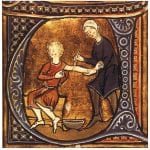The Black Death, also often called the “bubonic plague” was an epidemic of disastrous proportions that is said to have killed up to 50% of the European population in the 1300’s and around 12 million people in China in the 1800s.. According to historians, the Black Death came from the East (Either China or Mongolia) and reach Italy in 1348, during the spring. So many centuries later, it is hard to determine the exact cause of death, which is why several theories exist. The most widely adapted theory is that it was caused by rats, but other theories claim that it may have been a viral infection.
Bubonic Plague
According to the “bubonic plague” theory, the disease was a bacterium, Yersina pestis spread by fleas that lived on infected black rats, which typically live in close proximity to humans. Once a colony of rats has been killed off due to the disease, starving fleas would jump over on humans. Symptoms are flu-like, with headache, fever, weakness and swollen lymph glands or “bubos,” hence the name “bubonic.” Humans would show their first symptoms three days after infection and 80% of those died within five days after onset. The Bubonic plague still exists in pockets today, but thanks to modern medicine, only 1 out of 7 of those that become infected die. The fact that the Black Death claimed larger portions in the population in the countryside than in urban areas supports the fact that it was spread by fleas.
Pneumonic Plague
According to some scholars, the Black Death spread so quickly because the bacterium causing it has become airborne. In some cases, the infection would spread to the lungs, resulting in pneumonia. The victim would start coughing up blood, making transmission of the bacterium airborne, allowing it to spread much faster than fleas.
Ebola or Other Deadly Virus
According to some scholars, the Black Death’s spread was way too fast to have been caused by fleas and that it could have been caused by an Ebola-like disease. It has a lot of symptoms in common with Ebola and the period between the first person infected person dying and the rest of the population becoming sick, shares similarities with the incubation period of the disease. The sores or “bubos” people got, could have been hemorrhagic fever and according to medical journals of the time, quarantining families that were infected for 40 days was very effective in stopping the disease from spreading. This would not have been the case if it was spread by rats and fleas.
Until science can effectively detect a certain virus or bacterium in the skeletons of people who have lived centuries ago, we may not know the exact cause of the Black Death. History however gives us a cautionary tale of how easily infectious illnesses can spread in large populations if care is not taken to eradicate them quickly and efficiently.
This article is part of our larger selection of posts about the medieval period. To learn more, click here for our comprehensive guide to the Middle Ages.
This article is also part of our larger selection of posts about The Normans. To learn more, click here for our comprehensive guide to The Normans.
This article is also part of our larger selection of posts about Medieval Life. To learn more, click here for our comprehensive guide to Medieval Life.
Cite This Article
"What Was the Black Plague?" History on the Net© 2000-2024, Salem Media.
April 19, 2024 <https://www.historyonthenet.com/what-was-the-black-plague>
More Citation Information.









